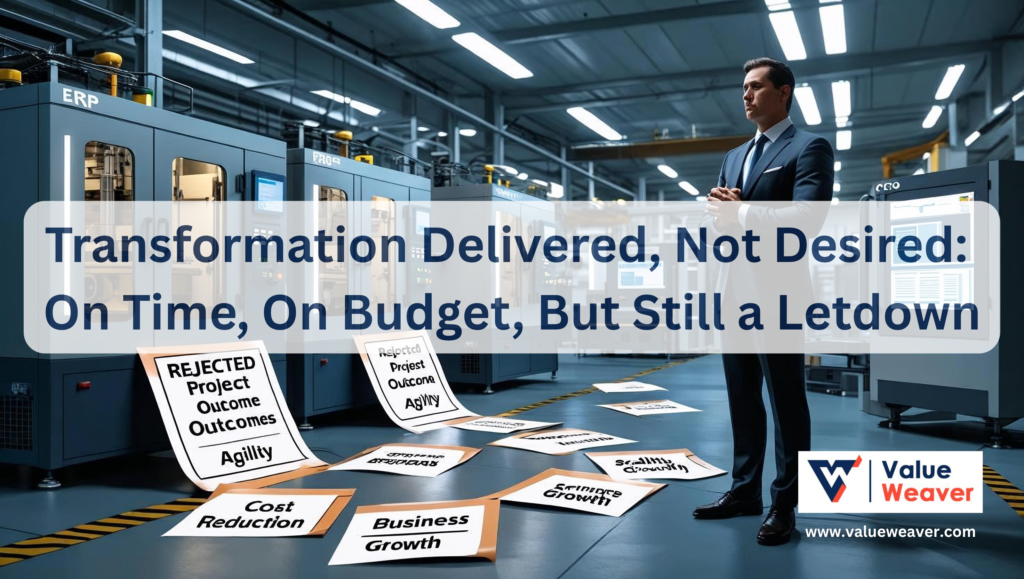Contact Info
- 2A Penrose Avenue, Woodley, Reading RG5 3PA
- +44-7528160272
- contact@valueweaver.com
- Office Hrs: Today 9.00am to 6.00pm
In today’s dynamic business landscape, transformation projects are essential to driving strategic growth and operational efficiency. Organisations often measure their success by traditional metrics: delivered on time, within budget, and meeting functional specifications. Yet, many senior leaders are increasingly frustrated when these “successful” projects fail to deliver the anticipated business value.
One of the most common reasons? They are mistakenly treated as IT projects, rather than as strategic business transformations.

Far too often, transformation programmes are led and executed from an IT perspective. This results in technically sound systems that function exactly as scoped — but bring minimal, if any, change to business performance.
Take, for example, a recent global procurement transformation at a multinational manufacturing company. The Source-to-Contract system was successfully implemented on time and within budget. However, six months post-go-live, business users were still relying on manual spreadsheets for supplier evaluation, and contract cycle times had not improved. Why? Because the solution had been configured to match the legacy process — rather than transform it. Procurement had minimal involvement beyond the initial requirements gathering, and change management was an afterthought.
Executives often encounter the same post-implementation frustrations across industries:
A large retailer deployed a best-in-class P2P platform globally. IT and Finance declared the project a success — ERP integrated, payments processed, audits passed. Yet, Procurement faced a backlash from suppliers due to a lack of onboarding support and inconsistent processes across regions. The platform’s supplier portal was technically functional, but poorly adopted. Business value — such as negotiated savings and increased contract compliance — was never realised.
Lesson: Without a business-led supplier enablement strategy, even the most sophisticated tools will fall short.
A public sector organisation upgraded its contract management system with digital signatures and automated workflows. While the system worked as designed, it merely replicated outdated approval chains. The business objective of reducing contract turnaround time was missed, and stakeholders reverted to offline processes.
Lesson: Functional delivery does not equal strategic transformation. Processes must be challenged, not just digitised.
To achieve true business value, transformation must be co-led by the business, with Procurement, IT, Finance, and Change functions working in lockstep. Here’s how top management can reframe the approach:
Start by defining and aligning around value-focused KPIs: e.g., cycle time reduction, supplier risk mitigation, or improved working capital. Build governance around these goals.
Make business stakeholders co-sponsors. For instance, have the CPO and CIO jointly own the transformation roadmap, with clear roles across Procurement, Finance, and IT.
In one successful case, a pharmaceutical company allocated 30% of the total transformation budget to change management — including Procurement champions, supplier training, and user-centric design. Adoption soared, and so did the value delivered.
Track beyond system usage: measure contract compliance, PO coverage, sourcing cycle time, and maverick spend trends. This ensures the technology is delivering strategic impact.
Instead of automating inefficiencies, use the transformation to standardise, simplify, and optimise end-to-end procurement processes.
Transformations fail not because systems don’t work, but because organisations fail to reimagine how they work. Procurement, like all business functions, must shift from being passive recipients of IT solutions to being active co-creators of strategic change.
For top management, the message is clear: If your transformation is led like an IT project, don’t be surprised when it delivers IT-level results — not business value.
| Cookie | Duration | Description |
|---|---|---|
| cookielawinfo-checkbox-analytics | 11 months | This cookie is set by GDPR Cookie Consent plugin. The cookie is used to store the user consent for the cookies in the category "Analytics". |
| cookielawinfo-checkbox-functional | 11 months | The cookie is set by GDPR cookie consent to record the user consent for the cookies in the category "Functional". |
| cookielawinfo-checkbox-necessary | 11 months | This cookie is set by GDPR Cookie Consent plugin. The cookies is used to store the user consent for the cookies in the category "Necessary". |
| cookielawinfo-checkbox-others | 11 months | This cookie is set by GDPR Cookie Consent plugin. The cookie is used to store the user consent for the cookies in the category "Other. |
| cookielawinfo-checkbox-performance | 11 months | This cookie is set by GDPR Cookie Consent plugin. The cookie is used to store the user consent for the cookies in the category "Performance". |
| viewed_cookie_policy | 11 months | The cookie is set by the GDPR Cookie Consent plugin and is used to store whether or not user has consented to the use of cookies. It does not store any personal data. |

Leave A Comment